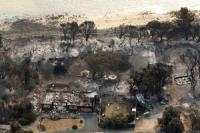-
Seismic monitoring network helps locate, determine origins of earthquakes in Texas
Almost a decade ago, the ground around the densely populated Dallas-Fort Worth Metroplex started shaking. As the frequency and intensity of earthquakes increased in a region poorly prepared for the seismic activity, the risk became a priority for the state. Residents, politicians, and oil-gas industry leaders reached out to the Bureau of Economic Geology. The bureau is the oldest and second largest research unit at the university, made up of more than 250 scientists, engineers, and economists. The organization also functions as the State Geological Survey of Texas — a broker of information among industry, academia and government agencies.
-
-
Evaluating critical mineral-resource potential in Alaska
A new method for evaluating the resource potential for large, underexplored regions for critical minerals in Alaska is now available online. Critical minerals are used in products that are vital to national security, technology, and also play an integral role in our everyday modern life.
-
-
EPA awards $100 million to Michigan for Flint water infrastructure upgrades
The U.S. Environmental Protection Agency (EPA) last week awarded a $100 million grant to the Michigan Department of Environmental Quality to fund drinking water infrastructure upgrades in Flint, Michigan. The funding, provided by the Water Infrastructure Improvements for the Nation Act of 2016, or WIIN, enables Flint to accelerate and expand its work to replace lead service lines and make other critical infrastructure improvements.
-
-
Recovery lessons from Hurricane Sandy to help improve resilience, disaster preparedness

Purdue University will lead a $2.5 million, four-year research to determine why some communities recover from natural disasters more quickly than others, an effort aimed at addressing the nation’s critical need for more resilient infrastructure and to enhance preparedness. The research team will apply advanced simulations and game-theory algorithms, access millions of social media posts and survey data collected along the New Jersey shore, which was devastated by Hurricane Sandy in 2012.
-
-
Assault weapons not protected by Second Amendment: U.S. appeals court

The U.S. Court of Appeals for the Fourth circuit ruled 10-4 to uphold Maryland’s ban on assault weapons, ruling that assault weapons are not protected under the Second Amendment of the U.S. Constitution. “Put simply, we have no power to extend Second Amendment protection to the weapons of war,” Judge Robert King wrote. “Both before and after Newtown, similar military-style rifles and detachable magazines have been used to perpetrate mass shootings in places whose names have become synonymous with the slaughters that occurred there,” he wrote.
-
-
Texas agriculture experts: Mexico may retaliate if U.S. imposes tariffs
Texas agricultural experts say President Trump’s threatened tariff on Mexican goods could lead to retaliation that would hurt Texas farmers and ranchers — as well as consumers. The idea of a tariff on Mexican imports or a radical change to the North American Free Trade Agreement worries many Texas agriculture industry leaders, who say it is in the state’s best interest to continue fostering a positive trade relationship with Mexico rather than imposing tariffs on their imports.
-
-
Six years after first attempt, fight over anti-sanctuary cities bill has changed
Bills targeting “sanctuary cities” failed to pass the Texas Legislature in 2011 and 2015, but similar efforts this session have better chances of making it to Gov. Greg Abbott’s desk.
-
-
Abbott vows to cut funding for "sanctuary campus" schools
Rebuking a growing movement aimed at protecting undocumented students under incoming President Donald Trump, Gov. Greg Abbott vowed Thursday to cut funding for any Texas school that declares itself a “sanctuary campus.” The definition of a “sanctuary campus” is murky, but Abbott made it clear they are not welcome in Texas.
-
-
Lawmaker wants to crack down on illegal hiring by state contractors
The federal E-Verify system, operated by the U.S. Citizenship and Immigration Services, screens for undocumented workers by comparing the information that job applicants submit to an employer with records maintained by the Department of Homeland Security and the Social Security Administration. A measure filed Monday in the Texas Senate would beef up punishment for employers that hire undocumented workers and seek to do business with the state.
-
-
NYC mayor said city would sue U.S. government over Muslim registry
New York City mayor Bill de Blasio said that the city would sue the U.S. government if Muslims were required, under a Donald Trump administration, to sign up to a “registry.” “We will use all the tools at our disposal to stand up for our people,” he said. The Muslim registry plan advanced by Trump supporters like Kris Kobach, the secretary of state of Kansas, would require all Muslims in the United States sign to a registry in which they would reveal their identity, religious beliefs, and political affiliations. In its original form, the registry requirement would apply to Muslim visitors to the United States – students, business people, and tourists – as well as to Muslim citizens of the United States.
-
-
Georgia lawmakers mull bill prohibiting wearing hijabs, niqabs, and burqas in public
A Georgia lawmaker wants to prohibit Muslim women from wearing hijabs, niqabs, and burqas in public. The proposed law would modify the original 1951 anti-masking law which targeted Ku Klux Klan members. The purpose was to prevent them from committing violence while preserving their anonymity by wearing their Klan hoods. The bill’s sponsor said the law would be expanded to women driving on public roads, making it a misdemeanor to wear a Muslim traditional headwear while driving. The language of House Bill 3, however, suggests the prohibition would apply to any public property, not only public roads.
-
-
Most border arrests by Texas troopers are not for drug smuggling
Officers with the Texas Department of Public Safety (DPS) have recorded 31,786 law violations along the Texas-Mexico border from late June 2014 through September 2016. Just 6 percent of the offenses were felony drug possession by “high-threat criminals,” or HTC — the criminals troopers were largely sent to stop. The other HTC priority is supposed to be human smugglers, but they made up just 1 percent of offenses. DPS has added more troopers to the border under the assumed objective that they are going after drug and human smugglers — but a close examination shows that most of their arrests are for drunk driving and misdemeanor drug possession.
-
-
Florida's Stand Your Ground law linked to rise in homicide rates in the state
Before 2005, Florida’s so-called “Castle doctrine” allowed the use of lethal force in situations where individuals believed there was an imminent threat of death or serious physical harm from an intruder within their own home. In 2005 Florida enacted the Stand Your Ground law, extending the “no duty to retreat” clause of the Castle doctrine, giving individuals immunity for using lethal force to defend themselves in public places, as well as on private property. Anew analysis shows that thechange in Florida’s self-defense laws has been linked with the state’s homicide rates going up by nearly a quarter.
-
-
Less crime, and fewer incarcerations: As New York became a safer city, prisons closed too

Overflowing prison populations and high rates of violent crime once made New York City a metaphor for the urban decay confronting America’s cities. But over the last two decades crime in the nation’s largest city has declined steeply, with murders plummeting from 2,200 in 1990 to 350 in 2015. New York City’s crime decline was coupled with a sustained and dramatic reduction in incarceration, allowing the state to close more than a dozen prisons and save tens of millions of dollars. New York is now not only the safest big city in the United States, but also one with the fewest incarcerations for its size.
-
-
Loophole in Rhode Island law allows domestic abusers to keep firearms, despite risks

Courts in Rhode Island rarely require abusers to turn in their firearms, even when orders prohibit them from possessing firearms under federal law and there is evidence they pose a lethal risk to victims, according to new research. examined 1,609 case files of protective orders filed in Rhode Island Family and District courts from 2012 to 2014. “In Rhode Island, domestic abusers are rarely required to turn in their firearms — even when they are federally prohibited from possessing them,” said one researcher. “Addressing this gap in the state’s law could help prevent risk of gun violence to potential abuse victims.”
-
More headlines
The long view
Smaller Nuclear Reactors Spark Renewed Interest in a Once-Shunned Energy Source
In the past two years, half the states have taken action to promote nuclear power, from creating nuclear task forces to integrating nuclear into long-term energy plans.
